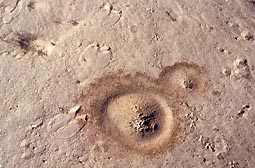 Wildlife in the desert will generally see, hear or possibly even smell an approaching human, while reptiles may sense vibrations. Ecological study of the fauna in this environment, where it is difficult to approach undetected, requires field skills to be finely developed. Nomadic bedouin acquired the skill to identify and track animals and much of what ecologists learn today is gleaned in the same way until it becomes second nature. Wildlife in the desert will generally see, hear or possibly even smell an approaching human, while reptiles may sense vibrations. Ecological study of the fauna in this environment, where it is difficult to approach undetected, requires field skills to be finely developed. Nomadic bedouin acquired the skill to identify and track animals and much of what ecologists learn today is gleaned in the same way until it becomes second nature.
The photograph shows the tracks of a camel passing close to a termites’ nest, by which a houbara had also walked some time earlier. In former times 'reading' the sands was a matter of survival, but this is no longer the case. Instead it has become a conservation research tool permitting animal populations, particularly of mammals and certain birds, to be assessed, their preferred food items and foraging range or territory to be determined and habitat requirements identified.  Armed with such information, protected areas will eventually be established, even if very few direct contacts are ever made with the relevant organism or organisms. For nocturnal desert species, such as sand cat (Felis margarita) and Ruppell's fox (Vulpes rueppellii), this is in fact very often the case. Armed with such information, protected areas will eventually be established, even if very few direct contacts are ever made with the relevant organism or organisms. For nocturnal desert species, such as sand cat (Felis margarita) and Ruppell's fox (Vulpes rueppellii), this is in fact very often the case.
|